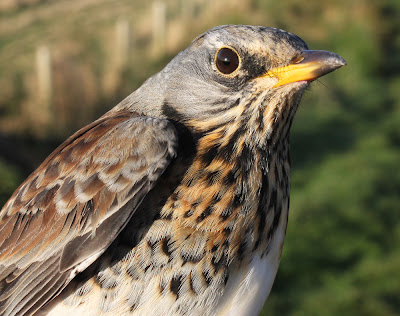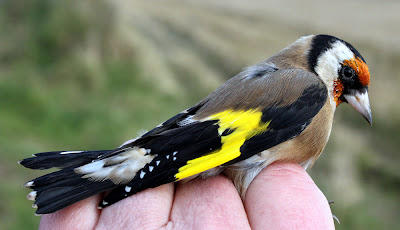Just too many competing priorities meant no birds this morning. At midday the sun still shone and the wind blew nil. So what is a man supposed to do but escape out onto the moss for a few hours of fresh air and birding before the weather turns again for the rest of the week? So I put up a few nets then sat in the warm sunshine taking in the view across the puddled wheat crop and over to the distant fells.
Afternoon On The Moss
11 birds caught at the feeders, 8 Goldfinch, 1 Lesser Redpoll, 1 Great Tit and 1 Chaffinch. So definitely not as productive as the morning might have been, but a pleasant couple of hours and a variety of other birds seen. I can’t resist taking more photographs of Lesser Redpolls, a stunning little bird. Fortunately enough it has in the last eight or ten years become much more locally common and numerous, especially in spring and autumn.
Lesser Redpoll
Not surprisingly, and after another downpour last night, the wet fields still hold a number of Snipe, impossible to say how many without walking every square inch to see and hear them explode from your feet as they zig-zag away to escape. It was the difficulties involved in hunting Snipe which gave rise to the term "sniper".
Snipe
Two hunting Kestrels today, and as I watched them came a fly-over of 6 Black-tailed Godwit and a large party of c 150 Lapwings and upwards of 1000 Starlings, all disturbed off a more distant field. During the couple of hours I saw 90/100 Fieldfares, ones and twos going in various directions, and then about 1600 hours a flock of 80 heading to a roost somewhere over towards Pilling. By 4 o’clock finches were heading to roost too, with 30+ Goldfinches flying north and 15/20 Chaffinches contact calling as they headed somewhere north but out of sight.
Other birds in the immediate area, 5 Skylark, 2 Meadow Pipit, 1Yellowhammer, 4 Linnet, 15 Tree Sparrow, 4 Lesser Redpoll, 2 Pied Wagtail, 12 Long-tailed Tit, 2 Goldcrest, 1 Buzzard.
I hadn’t seen a Little Owl here for weeks so as I drove off site about four-thirty I looked in all the trees they use until I found the right one.
Little Owl
The forecast isn’t good for the rest of the week but let’s not grumble, only count ourselves fortunate in comparison to the good folk of eastern USA who are about to experience a humdinger of a hurricane. Stay safe all you blog followers over there.
















































































